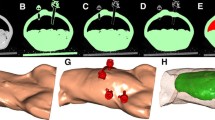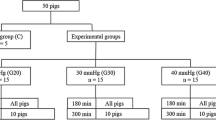Abstract
Background
Laparoscopic techniques in the treatment of various bowel diseases have become more and more popular in today’s clinical routine. However, knowledge about the impact of a carbon dioxide (CO2) pneumoperitoneum on the quality of healing of the intra-abdominal wound is rare. We therefore investigated the effects of pressure and gas type on anastomosis healing in a rat model.
Methods
Laparotomy and twofold ileo-ileal anastomosis was performed in 78 male Sprague Dawley rats. A CO2 or a helium pneumoperitoneum of 3 mmHg (each, n=18) or of 6 mmHg (each, n=12) was maintained before and after ileo-ileostomy. Rats in the control group (n=18) received no pneumoperitoneum. Animals were killed after 5 and 10 days. As indicator of bowel function, mean body weights were compared between the groups. One region of the anastomosis was subjected to computerised bursting-pressure measurements, while the second was explanted for subsequent histopathological examinations: collagen synthesis and degradation was determined by the ratio of collagen type I to type III and by the matrix metalloproteinase MMP-13. The extent of new mucosal layer formation was measured in haematoxylin and eosin (H&E)-stained sections.
Results
Alteration in mean body weight and the mean anastomosis bursting pressures did not differ between the groups. Likewise, histological examination revealed no statistically significant differences, either in the values for collagen I/III ratios or in the extent of mucosal proliferation. After 10 days, 6 mmHg helium pneumoperitoneum was associated with a more pronounced expression of MMP-13 than that of controls.
Conclusions
A CO2 pneumoperitoneum with pressures of 3 mmHg and 6 mmHg was found to have no significant impact upon the healing of anastomosis wounds in rats. Helium pneumoperitoneum offers no advantages over CO2.





Similar content being viewed by others
References
Robbins SB, Pofahl WE, Gonzalez RP (2001) Laparoscopic ventral hernia repair reduces wound complications. Am Surg 67:896–900
Kollmorgen CF, Thompson GB, Grant CS, van Heerden JA, Byrne J, Davies ET, Donohue JH, Ilstrup DM, Young WF (1998) Laparoscopic versus open posterior adrenalectomy: comparison of acute-phase response and wound healing in the cushingoid porcine model. World J Surg 22:613–619
Gutt CN, Kuntz C, Schmandra T, Wunsch A, Heinz P, Bouvy N, Bessler M, Sanger P, Bonjer J, Allendorf J, Jacobi CA, Whelan R (1998) Metabolism and immunology in laparoscopy. First workshop on experimental laparoscopic surgery, Frankfurt, 1997. Surg Endosc 12:1096–1098
Collet D, Vitale GC, Reynolds M, Klar E, Cheadle WG (1995) Peritoneal host defenses are less impaired by laparoscopy than by open operation. Surg Endosc 9:1059–1064
Agalar F, Hamaloglu E, Daphan C, Tarim A, Onur R, Renda N, Sayek I (2000) Effects of CO2 insufflation and laparotomy on wound healing in mice. Aust N Z J Surg 70:739–742
Kockerling F, Rose J, Schneider C, Scheidbach H, Scheuerlein H, Reymond MA, Reck T, Konradt J, Bruch HP, Zornig C, Barlehner E, Kuthe A, Szinicz G, Richter HA, Hohenberger W (1999) Laparoscopic colorectal anastomosis: risk of postoperative leakage. Results of a multicenter study. Laparoscopic Colorectal Surgery Study Group (LCSSG). Surg Endosc 13:639–644
Hartley JE, Mehigan BJ, Qureshi AE, Duthie GS, Lee PW, Monson JR (2001) Total mesorectal excision: assessment of the laparoscopic approach. Dis Colon Rectum 44:315–321
Yamamoto S, Watanabe M, Hasegawa H, Kitajima M (2002) Prospective evaluation of laparoscopic surgery for rectosigmoidal and rectal carcinoma. Dis Colon Rectum 45:1648–1654
Ishizaki Y, Bandai Y, Shimomura K, Abe H, Ohtomo Y, Idezuki Y (1993) Changes in splanchnic blood flow and cardiovascular effects following peritoneal insufflation of carbon dioxide. Surg Endosc 7:420–423
Bongard F, Pianim N, Dubecz S, Klein SR (1995) Adverse consequences of increased intra-abdominal pressure on bowel tissue oxygen. J Trauma 39:519–524
Diebel LN, Wilson RF, Dulchavsky SA, Saxe J (1992) Effect of increased intra-abdominal pressure on hepatic arterial, portal venous, and hepatic microcirculatory blood flow. J Trauma 33:279–282
Kologlu M, Sayek I, Kologlu LB, Eng C, Onat D (1999) Effect of persistently elevated intraabdominal pressure on healing of colonic anastomoses. Am J Surg 178:293–297
Polat C, Arikan Y, Vatansev C, Akbulut G, Yilmaz S, Dilek FH, Gokce O (2002) The effects of increased intraabdominal pressure on colonic anastomoses. Surg Endosc 16:1314–1319
Junqueira LC, Assis Figueiredo MT, Torloni H, Montes GS (1986) Differential histologic diagnosis of osteoid. A study on human osteosarcoma collagen by the histochemical picrosirius-polarization method. J Pathol 148:189–196
Berguer R, Cornelius T, Dalton M (1997) The optimum pneumoperitoneum pressure for laparoscopic surgery in the rat model. A detailed cardiorespiratory study. Surg Endosc 11:915–918
Neuberger TJ, Andrus CH, Wittgen CM, Wade TP, Kaminski DL (1996) Prospective comparison of helium versus carbon dioxide pneumoperitoneum. Gastrointest Endosc 43:38–41
Kuntz C, Wunsch A, Bodeker C, Bay F, Rosch R, Windeler J, Herfarth C (2000) Effect of pressure and gas type on intraabdominal, subcutaneous, and blood pH in laparoscopy. Surg Endosc 14:367–371
Naude GP, Bongard FS (1995) Helium insufflation in laparoscopic surgery. Endosc Surg Allied Technol 3:183–186
Eljaafari A, Duperrier K, Mazet S, Bardin C, Bernaud J, Durand B, Gebuhrer L, Betuel H, Rigal D (1998) Generation of stable monocyte-derived dendritic cells in the presence of high concentrations of homologous or autologous serum: influence of extra-cellular pH. Hum Immunol 59:625–634
Gutt CN, Heinz P, Kaps W, Paolucci V (1997) The phagocytosis activity during conventional and laparoscopic operations in the rat. A preliminary study. Surg Endosc 11:899–901
Stadelmann WK, Digenis AG, Tobin GR (1998) Physiology and healing dynamics of chronic cutaneous wounds. Am J Surg 176:26S–38S
Wiedemann H, Chung E, Fujii T, Miller EJ, Kuhn K (1975) Comparative electron-microscope studies on type-III and type-I collagens. Eur J Biochem 51:363–368
Jonsson K, Jensen JA, Goodson WH, III, Scheuenstuhl H, West J, Hopf HW, Hunt TK (1991) Tissue oxygenation, anemia, and perfusion in relation to wound healing in surgical patients. Ann Surg 214:605–613
Kahari VM, Saarialho-Kere U (1997) Matrix metalloproteinases in skin. Exp Dermatol 6:199–213
Savage FJ, Lacombe DL, Boulos PB, Hembry RM (1997) Role of matrix metalloproteinases in healing of colonic anastomosis. Dis Colon Rectum 40:962–970
Vaalamo M, Mattila L, Johansson N, Kariniemi AL, Karjalainen-Lindsberg ML, Kahari VM, Saarialho-Kere U (1997) Distinct populations of stromal cells express collagenase-3 (MMP-13) and collagenase-1 (MMP-1) in chronic ulcers but not in normally healing wounds. J Invest Dermatol 109:96–101
Thomson IA, Fitch W, Hughes RL, Campbell D (1983) Effect of increased concentrations of carbon dioxide during halothane anaesthesia on liver blood flow and hepatic oxygen consumption. Br J Anaesth 55:1231–1237
Acknowledgements
We would like to thank Karl Storz GmbH, Germany, for the kind use of an insufflator modified for helium gas and Mrs Ellen Krott for careful assistance during this investigation.
Author information
Authors and Affiliations
Corresponding author
Rights and permissions
About this article
Cite this article
Rosch, R., Stumpf, M., Junge, K. et al. Impact of pressure and gas type on anastomotic wound healing in rats. Langenbecks Arch Surg 389, 261–266 (2004). https://doi.org/10.1007/s00423-004-0491-x
Received:
Accepted:
Published:
Issue Date:
DOI: https://doi.org/10.1007/s00423-004-0491-x




